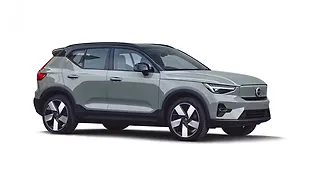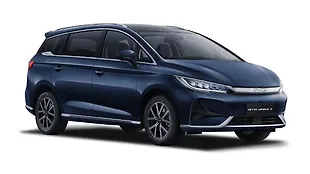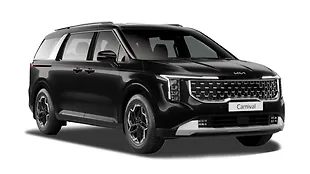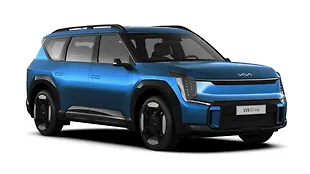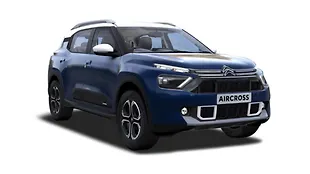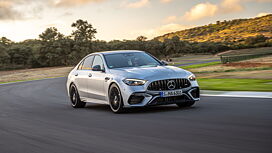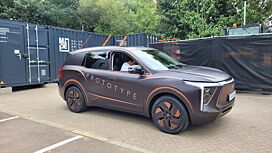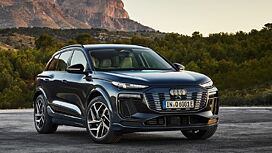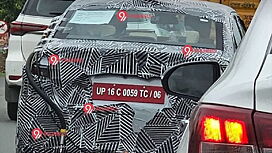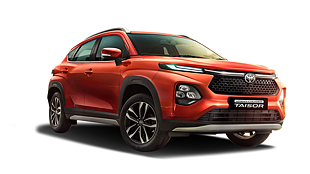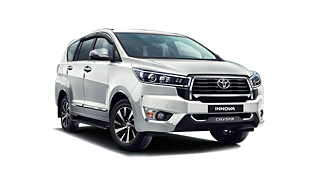Overview

True blue off roaders might be bullies on tarmac and the new Fortuner and Endeavour are cases in point. But is there more to these SUVs? And how do these compare against each other? AUTO BILD INDIA finds out
Old school SUVs are more than just massive vehicles used to bully road users in the city. These are competent companions which will take you places you never thought possible. And if just that thought alone isn't sexy enough; imagine the possibilities with one your garage. If you can, you’d love both the Endeavour and the Fortuner; with their low range gearboxes and body on ladder frames these can metaphorically take to you to the edge of the world.
Exterior & Interior

Dash design like the exteriors of the Endeavour is more straight cut. It's also short on equipment but there's a sat-nav, and it works well too

Off road, the Ford is more fun. It also breaks traction easily
However, if you also prefer good looks, the Toyota is your answer. The Endeavour has always been a great example of brawn over beauty styling thanks to its large proportions and straight cut lines that give it a serious sense of purpose. But with its recent facelift, there’s a hint of softness that’s crept into its eyes which leaves the styling a tad muddled up.
The Fortuner’s design is more balanced. It’s still more rugged than sweet, more massive than sporty but people still won’t always expect you to arrive laden in dirt in the Toyota, like they would if you were in the Ford. Inside too, it’s more comfortable, ergonomically sound and better equipped; there’s climate control and a multi functional steering, a comprehensive trip computer and stowage spaces abound. There are lots of cup and bottleholders all round as well to make long journeys comfortable for all its passengers.
Moreover, it has comfy and accommodating seats. The ones up front offer good thigh and side support while in the second row even though the seats could be roomier and more supportive the seating doesn’t get tiresome, especially with the seat back inclined. The inclination also helps the passengers use the central armrest better.
The Fortuner has better third row seats too; the thigh support is acceptable as is the shoulder and kneeroom.
The Ford’s insides seem to put adventure ahead of comfort. It’s not as well equipped even it does get a sat-nav which works well. The seats aren’t as comfy as the Toyota’s either. These lack back and thigh support, both at the front and at the back. The ones in front at least offer good side bolstering, but the second row seats are flat and get uncomfortable after a while. And the less said about the last row the better.
Space utilisation too could be better on the Ford. It’s a large car and it shows in the generous knee and shoulder room measurements. But head room isn’t great. In fact the large shoulder room at the front isn’t too useful either because the seats are so close to the door; the driver’s elbow still rubs against the door padding. It does nonetheless get a surplus set of cubby holes and cupholders, necessary for a long and adventurous drive.
The Toyota is in fact the better of the two on tarmac. It’s stiffly sprung like the Ford and like it the ride characteristic improves appreciably with load and speed. But unlike the Endeavour, which tends to skip about over broken tarmac thanks to the conventional setup of leaf springs at the back, the Fortuner feels surer and more planted. It also has better steering feel and much better handling on tarmac. It does roll about, but there’s more feedback from the Toyota and it feels more controllable too. Even on dirt, thanks to all time four wheel drive, there’s less under or oversteer to deal with. Moreover, the tyre grip is simply superb.
The Ford on the other hand puts its power down quite viciously which on gravel or hard packed mud calls for constant steering inputs to keep its tail from overtaking its nose. It is quite a bit of fun, but can get scary for amateurs. While on tarmac, with so much bulk and body roll, the turn in is lazy and one has to fi ght understeer, especially around tighter corners like hairpin bends on a hill road.
It does have great high speed cruising ability though. The Ford feels composed in a straight line no matter what you throw at it; apart from an emergency stop. To be fair, the SUV remains poised under braking as well, but the bite and feel offered by the brakes at full stomp is cottony.
It’s a similar story with the Toyota; for most part of the operation the brake feel and bite is good, but brake hard and the pedal simply melts into the floor. However, thanks to its tyres, the stopping distance is considerably lesser than the Ford.
Engine & Gearbox

Ford Endeavour The Ford's engine is almost 15bhp down on power and 13Nm down on torque. It's also coupled to an automatic gearbox as compared to amanual transmission on the Toyota
The Endeavour’s drivetrain is well suited for the long haul as well. The 3-litre engine is now coupled to a 5-speed automatic. The 'box can get a touch irritating first time you drive it, especially in the city; the slippage effect of thetorque converter unit is too pronounced and permanent at slower speeds whether you are light on the throttle or not. And the accompanying engine drone can almost give you a headache.
But it works well on the highway at over 80kmph with the 'box having settled in overdrive; the drivetrain is a lot more relaxed and quiet at this time. Spend more time with the 'box, and you begin appreciating it further. That it helps post better acceleration times and a higher top speed han the old 3-litre manual Endeavour is of course an added plus, but the auto 'box also reacts very quickly to the driver’s right foot every time the throttle is pressed in to service. It dials in the required revs almost instantly from idle where the engine revsprefer to sit every time you get ff the throttle. We also prefer the Ford’s automatic setup for off roading.

Toyota Fortuner The more powerful and torquey engine of the two, it also helps propel the Toyota quicker to 100kmph and to a higher top speed as well. It does get noisy at higher speeds though
Not that the Toyota isn’t good; its 171bhp 3-litre engine is very agreeable indeed. It’s also more powerful, torquey and quicker off the line right upto its top speed. In fact, the gap against the Endeavour just keeps increasing as the speeds rise. But, it isn’tthe quietest or the most refi ned diesel engine we have tested.
It’s also slower than the Ford in the roll on tests, a measure of a vehicle’s driveability. But that’s solely down to the 5-speed manual 'box against the 5-speed automatic unit of the Endeavour. Even so, the Toyota never leaves ou wanting when the throttle pedal is called into operation; it surges ahead with intent and profi ciency and that makes it a great highway tool as well.
Dimensions
Ford Endeavour (mm) | |
 |  On the Endeavour, last row of seats can be removed for more luggage room |
Toyot a Fortuner (mm) | |
 |  On the Toyota, the last row seats split in half and fold up to liberate space |
Scorecard & Verdict
 Ford Endeavour- The Endeavour is a fun SUV in the dirt, but it needs more than a satnav and facelift to challenge the Toyota.
Ford Endeavour- The Endeavour is a fun SUV in the dirt, but it needs more than a satnav and facelift to challenge the Toyota.
 Toyota Fortuner- With its better equipment, performance and fuel economy, the Fortuner wins this quite easily.
Toyota Fortuner- With its better equipment, performance and fuel economy, the Fortuner wins this quite easily.
Scorecard
Body: The Ford is the roomier of the two here, no question, but we expected the space utilisation to be better. Quality of materials are more or less the same on both SUVs and so is the fit and finish. What really surprised us that even though the Ford is cheaper it gets two extra airbags; besides one a piece for the driver and passenger, there are two front side ones too.
Drive: It's under this head that the Toyota truly marches ahead. Both SUVs have poky diesel engines but both could do with a little more refi nement. The Fortuner, thanks to its more powerful and torquey engine, is quicker and the Ford, thanks to its automatic gearbox, offers better driveability. But the latter also saps the Endeavour of effi ciency, fuel efficiency that is.
Comfort: The ride is stiff on both the Ford and the Toyota, but the latter's rear handles broken tarmac with more authority. It also has better seats front and back. Better ergonomics and more tactile feel from the switches and knobs see it earn an extra point in operability over the Ford as well. Ford is the quieter of the two though.
Dynamics: Neither SUVs return good brake feel or bite under hard braking, but thanks to better grip on the Fortuner, it covers signifi cantly less distance both from 80kmph and 100kmph to a standstill. Steering response is the same on both as is their straight line stability. The Toyota is easier to park however.
Cost: There's isn't much difference in the pricing of the SUVs with the Ford being slightly cheaper to purchase. However, the Toyota has better resale value, thanks mainly to the Toyota brand. It also has a much better warranty in its favour. As a result it lands another powerful blow under this head.
Verdict
The Fortuner is more stylish, ergonomically sound and comfortable. It’s also better built and equipped and more accomplished on tarmac. As for off-roading abilities, both the Ford and the Toyota are equally competent and both will get you out of most sticky situations easily. The Toyota is more expensive, but then you will also get better resale value for it and with its considerably better fuel economy, the overall ownership cost at the end will not be drastically different.

![Toyota Fortuner [2012-2016] Image Toyota Fortuner [2012-2016] Image](https://imgd.aeplcdn.com/272x153/cw/cars/toyota/fortuner.jpg?q=80)









